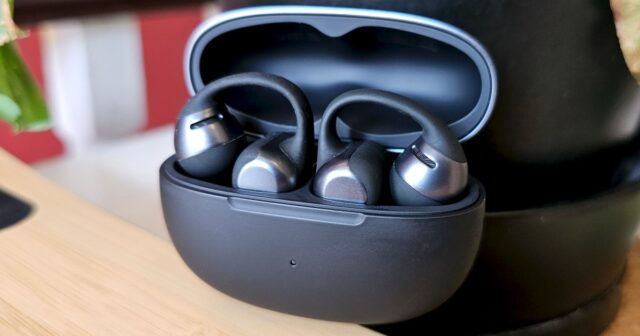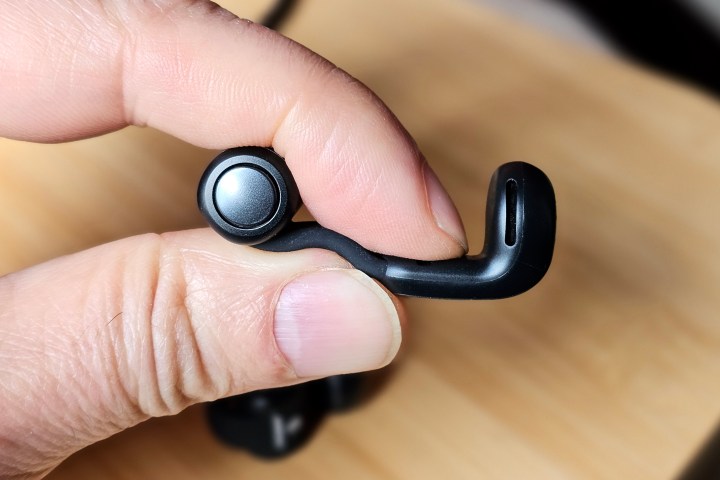Shokz OpenDots One
MSRP $200.00
Pros
- Light and pocketable
- Impressive bass response
- Wireless charging
- Excellent battery life
Cons
- Expensive
- Limited controls
When it comes to open-ear earbuds, there are two main styles: earhooks or clips. While great for stability, earhooks don’t always play nicely with glasses. They also have a bulky appearance, and they typically position the speaker outside the ear’s concha, making it harder to direct sound into the ear canal. The clip style, which, as the name suggests, wraps around the side of your ear, addresses these weaknesses, and now Shokz has debuted its first clip-style model, the $200 Shokz OpenDots One.
The clip-style category already has plenty of options, including models from brands like Bose, Soundcore, and Soundpeats. Have the Shokz OpenDots One carved out a niche for themselves, or should you look elsewhere? Let’s check them out.
Design

Before we get into the design itself, a quick note on the name. In 2023, prior to releasing its earhook-based Shokz OpenFit, the company briefly sold a similar device called the Shokz OpenDots. Though very few people ever owned them (in fact, a Shokz spokesperson referred to them as a beta product), the company wanted to keep the OpenDots name while avoiding any confusion with that early open-ear product — thus, OpenDots One.
If I were to describe the OpenDots One in a single word, it would be “pocketable.” Shokz has gone out of its way to make these earbuds as small as possible. That includes the charging case, which is the smallest I’ve seen so far for a set of open-ear earbuds.
The buds resemble the $299 Bose Ultra Open Earbuds, with a very flexible connector joining the main speaker module with a barrel-shaped battery compartment. The buds offer IP54 protection from dust and water — good for rain and sweat, but not much else.

Where Bose draws attention to the Open Ultra, using a metallic-finish inlay on its speaker module and a whopping 10 color choices, Shokz has given the OpenDots One a more demure visage. The connector is covered in Shokz’s matte-finish, ultra-soft silicone, and the two modules have subtle, satin-finish accents. You can choose from black or grey (more of a beige) colors.
There are two ways to use the touch controls. You can tap anywhere on the flexible connector or the back of the battery compartment, or you can use your index finger and thumb to pinch the top and bottom of the barrel. That pinching movement is how the Open Ultra Earbuds work, too, but Bose uses a physical button, while Shokz’s version is touch-based.
The OpenDots One also have a clever trick: there’s no preset right or left earbud. Onboard sensors determine the orientation when you put them on and automatically assign the correct channel. You can override these sensors using the Shokz app, but I’m not sure why you’d want to.
Similarities to Bose’s design continue with the way the OpenDots One sit in their case — mostly exposed once the lid is open, making it super easy to grab them.
Speaking of the case, Shokz one-ups the more expensive Bose buds by including wireless charging.
Shokz OpenDots One specs
| Price | $200 |
| Weight | 0.23 oz (each earbud), 1.38 oz total with charging case |
| Form factor | Open earbuds (clip style) |
| Noise cancellation | None |
| Battery life | 10 hours per charge, 40 hours total with charging case |
| Charging | USB-C, wireless |
| Voice assistant | Native smartphone access |
| Multipoint | Yes |
| Water/dust resistance | IP54 (earbuds only) |
| Hi-res audio | No |
| Fast pairing | No |
| Bluetooth/codecs | BT 5.4 with AAC, SBC |
| Auracast | No |
Comfort, controls, and connections
- 1.
Shokz OpenDots One - 2.
Bose Ultra Open Earbuds
With very few exceptions, all open-ear earbuds are very comfortable even for prolonged use. The same goes for the clip-style, but this is where personal preference (and possibly your ear’s anatomy) comes into play.
I’ve been wearing the OpenDots One for a week now, often leaving them in for the entire day. After several hours, I notice pressure where the speaker module touches the inside of my concha. It’s never painful, but I do need to give myself a break for a few minutes before putting them back in.
I say it may be an anatomy thing, because only my right ear is affected; the left ear is always comfortable.
The fit is very secure. Some clip-style buds can shift around, which not only affects comfort but can also impact sound quality. The OpenDots One stayed put, even when at the gym.
Both touch gestures work well, with the pinch gesture proving more accurate for me. I still prefer a physical button — way easier to use, especially with gloved hands — but that’s not the biggest reason I prefer Bose’s implementation. For reasons known only to Shokz, there are only two tap gestures: a double-tap (or double pinch) and a long pinch, and only the long pinch can be customized.
Play/pause is always available via the double-tap, leaving the long pinch as your only option for track skipping, volume adjustment, and voice assistant access. You can pick one.

Shokz did the same thing on the first-gen OpenFit, and I found it just as baffling.
Worse still, when I asked about the limitation, I was told there’s no way around it, and it can’t be fixed via a firmware update. Bizarrely, Shokz also said that a second-gen OpenDots One is already in the works, and it will have a button. So I guess if you want more control, you should wait.
The OpenDots One sport wear sensors, an unusual feature for open-ear earbuds. They do what you’d expect, pausing music when you remove a bud and resuming when you wear it. Auto-pause isn’t as reactive as I’d like; it can take up to two seconds to kick in. Auto-resume, on the other hand, is nearly instant.
You don’t get Google Fast Pair support on the OpenDots One, but pairing is still very easy and fast using the Bluetooth menu on your phone. With Bluetooth 5.4, the connection is very stable, though not over long distances. With most wireless earbuds, I can walk around my house and remain connected when I leave my phone on the second floor. The OpenDots One seem to have a shorter leash, dropping out once I got further than about 25 feet away.
Bluetooth Multipoint works flawlessly and Shokz makes it easy to see and select your paired devices in the companion app.
I’m disappointed that Shokz still has no plans to support Bluetooth Auracast, a feature that lends itself well to all-day earbuds like the OpenDots One.
Sound quality

Shokz uses two 11.8mm drivers in each speaker module, oriented toward each other. It says this design delivers deep, powerful bass, equivalent to a 16mm dynamic driver. While I didn’t have an actual set of 16mm driver earbuds as a comparison, I can safely say the OpenDots One deliver some of the best bass I’ve ever heard in a set of open-ear earbuds.
I suspect it’s actually a combination of the driver setup and the placement of the speaker module. The closer you get to the ear canal, the less bass you lose.
The overall sound signature isn’t as balanced as you’ll get from the Bose Ultra Open Earbuds — the OpenDots One are a bit shy on midrange detail — but there’s good clarity and no distortion even at the loudest volume.
Just remember, unless you’re indoors in a quiet location, you can’t expect miracles from any open-ear earbuds. Noises around you will interfere with sound quality; it’s just the nature of the open-ear beast.
The Shokz app offers two EQ presets (Vocal, Bass Mode) plus a third setting called Private Mode, which attempts to reduce possible sound leakage by increasing bass and reducing some highs. To test this, my wife and I stood three feet apart in a quiet room. After switching modes (at 70% volume), she said it made no difference to the amount of sound she could hear. The good news is that the earbuds probably don’t need Private Mode — my wife said it was impossible to tell what song I was listening to, and doubted she’d be able to make out speech from a phone call.
You can also access a five-band equalizer to create your own EQ mixes, which can be saved under their own names.
Finally, there’s an optional Dolby Audio mode. It creates a slightly wider soundstage, though it shouldn’t be confused with Dolby Atmos Music or spatial audio — it’s not aiming for that level of 3D immersion.
It works well; you can hear that expanded sense of space. It’s not as immersive as the Immersive Audio option on the Bose Ultra Open Earbuds, and it’s not as open-sounding as the Shokz OpenFit 2. So that’s the flip side of the coin: The OpenDots One create better bass because they’re closer, while the OpenFit 2 create a bigger sense of space because they sit further away.
Call quality
Indoors, calling in the OpenDots One is excellent. My voice was reproduced with very good clarity. Outside, or in noisy environments, the buds struggled a bit more as they tried to cancel out those background sounds.
Unlike the Shokz OpenFit 2, which are absolute champs at suppressing noise during calls, the OpenDots One just aren’t quite as effective.
Still, as with all open-ear earbuds, the main benefit is being able to hear your own voice, making calls of all kinds far more natural and less tiring.
Battery life

Shokz pegs battery life on the OpenDots One at 10 hours per charge, with an additional three full charges in the case, bringing total battery life to 40 hours. That assumes 50% volume, which likely won’t be enough when you’re outside, so your real-world performance will be closer to 8.5 hours.
Still, that’s a perfectly adequate number given that most people won’t listen to music (or podcasts or audiobooks) for 8.5 hours consecutively. More importantly, it’s far better than you’ll find in most clip-style open-ear earbuds, which aren’t known for their stamina.
For comparison, these numbers are only slightly less than the earhook-based Shokz OpenFit 2 (11/48), which have a much larger charging case.
Conclusion
Clip-style open-ear earbuds are a hot trend right now, and the Shokz OpenDots One are a great option for those who want what open-ears offer, but may dislike the fit or shape of a traditional earhook design.
At $200, they’re on the pricey side — only the Bose Ultra Open Earbuds are more expensive — and I’m not thrilled with the limitations on their touch controls. You should definitely check out other clip-style options before you buy, like the Soundcore AeroClip, Soundcore C40i, and Soundpeats PearlClip Pro. They’re all less expensive and can’t match all of the OpenDots One’s features, but if you don’t need wireless charging (for instance), why pay more for it?
However, with excellent bass response, a very comfy and secure fit, Bluetooth Multipoint, and wireless charging, the Shokz OpenDots One tick a lot of the boxes that other open-ears can’t. Plus, they’ve got one of the smallest, most pocketable charging cases on the market.
If that sounds like music to your ears, grab ‘em. I think you’ll be very happy.


















































